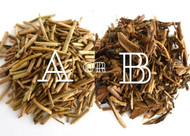Quiz: Which is the better Houjicha?
Posted by Yuki on 13th Mar 2021
Today, we'll be talking about the color of Houjicha.
The quality of tea is sometimes more than meets the eyes - but it's still good to know about some visual quality indicators. Take a look at the picture of the 2 Houjicha below.
Which is the better Houjicha, A or B?
Let’s do a quick infusion to take a look at the water color of the two Houjicha as well. I've infused both teas exactly the same - by using one heaping teaspoon of Houjicha to 200ml of boiling water, brewed for 30 seconds.
Here's how they look.
Now let's get back to these Houjichas.
Taking a look at the visuals
Firstly, let's dive into the details of how these two Houjichas look.
Which is the better Houjicha?
If you chose "Houjicha A" to be the better Houjicha, well Congratulations! That is correct.
In this case, the Houjicha A on the left is the better Houjicha. (When I say "better" here - it means it is considered a higher grade. Probably a higher chance you'll like it "better", but of course this always depends on your taste!)
The actual products in the picture
Houjicha A:
Houjicha B:

